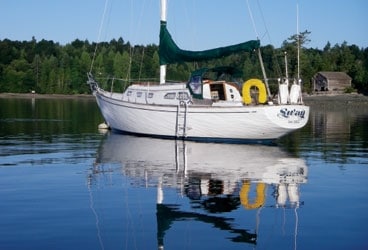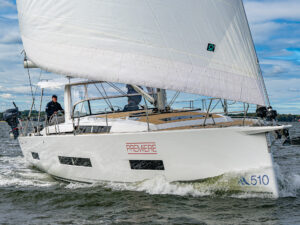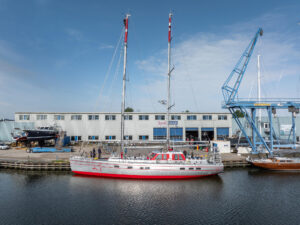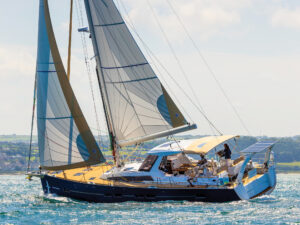
Ericson30
From the 1960s to the late 1980s, California-based Ericson Yachts produced thousands of sailboats. One of the first models to emerge was the Ericson 30, designed by Bruce King; 150 were built between 1966 and 1970.
The E30’s high bow, sheer, and balanced overhangs are complemented by teak toerails and the tall, rounded coachroof that sweeps upward forward of the comfortable cockpit. Wide side decks make it easy to move forward inside the shrouds.
Touted as a racer/cruiser, the E30 raced successfully under the C.C.A. rule. A long, swept-back fin keel containing 3,000 pounds of encapsulated lead ballast works with the rudder hung on a partial skeg to keep the boat balanced on all points of sail. At 35 feet, the rig is short by today’s standards, making big overlapping jibs necessary for light airs. The tiller head is near the middle of the cockpit sole, and with the traveler located on the small aft deck and well-placed winches, the boat is convenient to singlehand.
Below, it offers 6-foot-2-inch headroom in a wood interior with bulkheads bonded to the hull. A one-piece fiberglass headliner brightens the cabin and provides structural support but restricts access to many of the deck fittings. Ten fixed ports admit lots of light, while a large forward hatch provides ventilation.
The galley is at the foot of the removable companionway steps, with a two-burner alcohol stove and oven to port and a deep sink and icebox to starboard. In the saloon, a long settee and bookshelf face a U-shaped dinette. Both convert to large sleeping berths. Forward of the main bulkhead is a hanging locker; opposite is a small, well-appointed head, its door serving also to separate the V-berth from the rest of the interior. The split V-berth sits high, above the stainless-steel water tank, the 10-gallon plastic holding tank, and stowage.
The balsa-cored deck is solid wherever hardware is attached. But beware: Not all fittings are fastened with backing plates. The chainplates are bonded to the inside of the hull, and this arrangement makes it difficult to inspect them. The deck is bolted to the solid fiberglass hull, and the joint is fiberglassed. The resulting watertight seal rarely causes concern. Ericsons of this era generally don’t exhibit any osmosis.
Access to the original Atomic 4 and its 20-gallon gasoline tank is through a door behind the steps or from the cockpit via the cavernous lockers afforded by the lack of quarter berths. Most E30s around today have been repowered with diesels.
An unusual feature of the boat is that the propeller exits the hull above the rudder. While this protects the prop behind the partial skeg, it makes maneuvering in tight quarters an adventure.
In the Ericson 30, I found what I wanted: a boat I could afford that was large enough to live on and small enough to learn on. Similar vessels are listed at prices from $14,000 to $29,000, and the Ericson Owners Association (www.ericsonyachts.org) is a valuable source for more information about this and other Ericson models.
Vincent McGowan, his wife, Traci, and their son, Nathan, sail their 1969 Ericson 30, Sway, on Puget Sound.








